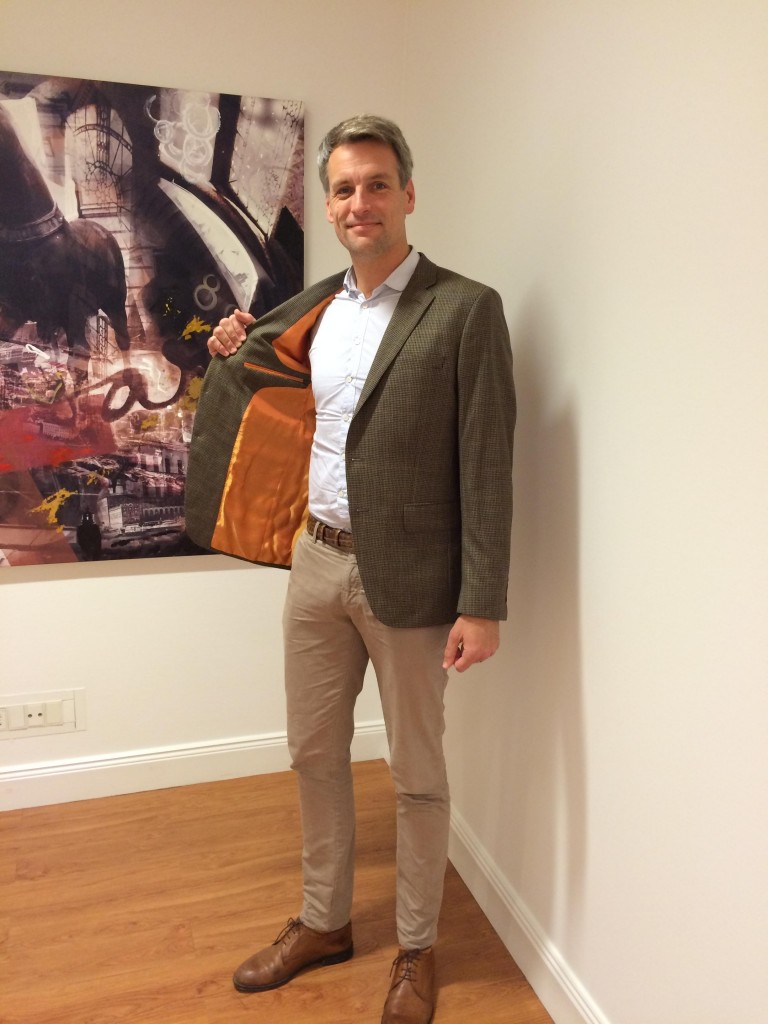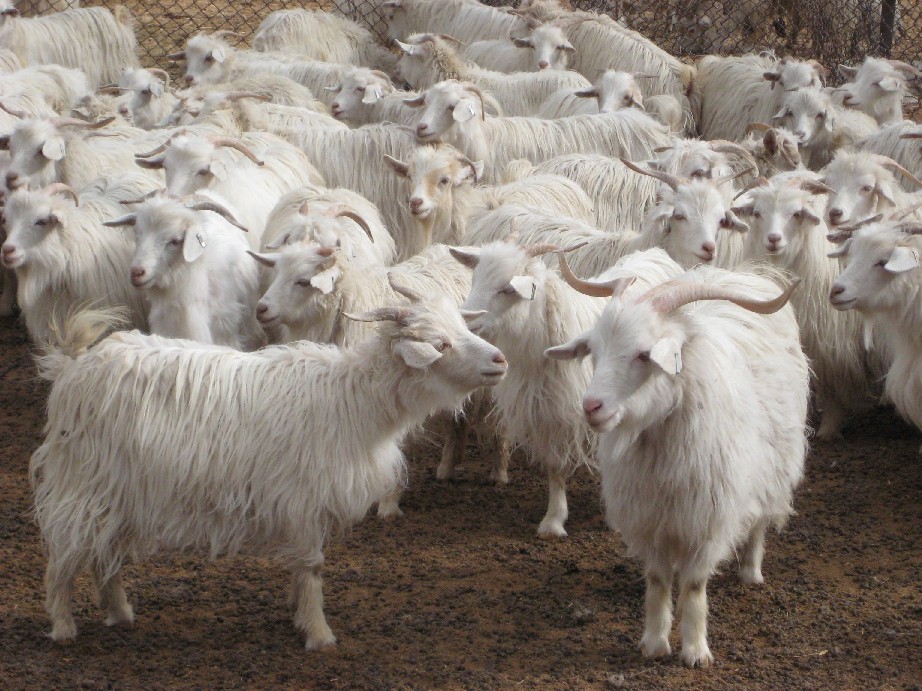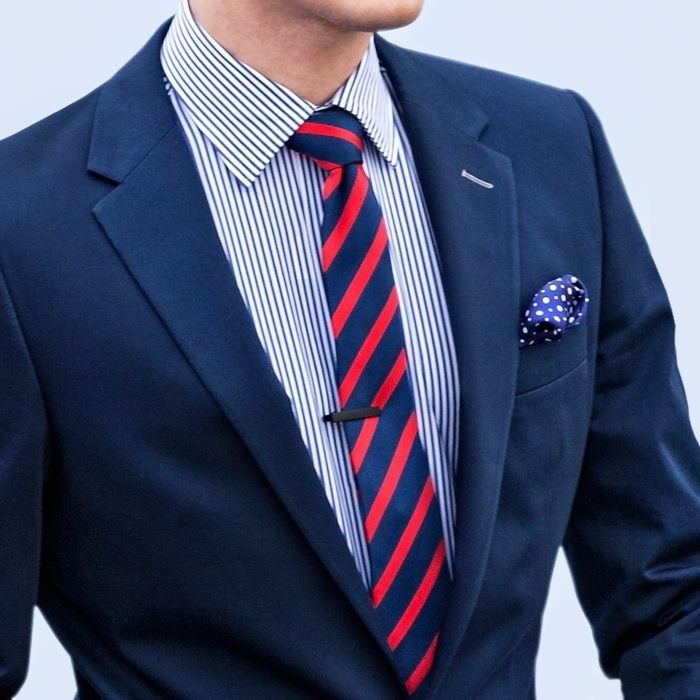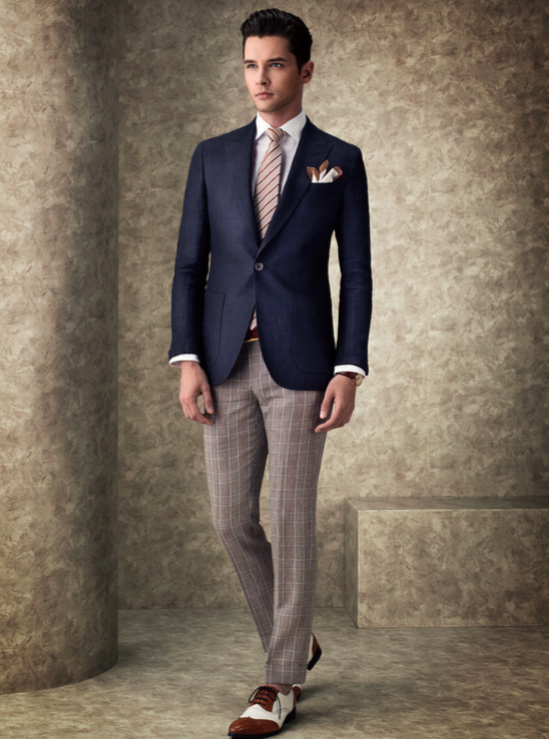Thank god February is such a short month, and good news, in a few weeks Spring officially starts! Spring is a great time to make some changes in our wardrobe. There is spring cleaning and, of course, shopping, since it is the best time to add something new to your wardrobe. So, why not cheer up with some color in your wardrobe. When talking about suits, checks are definitely in this spring!A check suit is a perfect option for everyone – you can have your suit made really colourful with a bold pattern or you can choose modest colours for your suit, but make it shine with a colourful lining that only you (and well, maybe some closest people also) know exists. This option is good for those working in an office with a bit of strict dress code.Some people might feel they need to be a bit careful with checked suits, but there is actually no reason to be. Check style is a casual and simple way to lift a look and stand out from the crowd. So yes, wearing checks will lead to you being checked out more, which means you should totally be comfortable in your suit. So, how to choose the perfect one for you? We’ll give you some tips:* Go for a print you’re comfortable with. If patterns are new to your wardrobe, start with the classic: a solid Prince of Wales check suit in a natural shade of navy or grey is a good place to start. If you like to be seen and noticed – go for the bold prints.* Don’t be scared. The beauty of a check suit lies in simplicity. It’s actually really hard to go wrong with these. The number one and easiest rule is that all checked suits need a muted, tonal piece to go with it- an understated shirt, tie and formal lace-ups add a clean finish. You can’t go wrong with that. Mixing different patterns need more knowledge. So start simple.* Combine! Wearing a full check suit is very stylish and festive. But if you need a more casual style, separate your suit. Try to wear your blazer with jeans, or your checked pants with a crisp shirt or comfy turtleneck. It looks casual without losing elegance!* New trends come and go but checks are timeless. They will never go out of style, but will always make a statement. So, treat it as an investment purchase.Why not to be bold and opt for a check suit this season? Get some inspiration from these pictures:Check Mate!(Photos from Marzoni Lookbook)
The ABC of looking like a gentleman
For many, dressing like a man who looks like he just walked out of a “Mad Men” set can very well be the definition of a gentleman. But, looking dapper in a bespoke suit doesn’t always equate to being a gentleman, as we also need to see chivalry, good behaviour and principles. However, people don’t instantly know who you are in seconds – so it’s what you’re wearing that gives the first impression. And believe me, you do want to create a perfect first impression because, as you may already know, society can be highly judgemental. So why not play along with this game and impress your boss, clients and the ladies?Looking stylish and elegant doesn’t have to cost you a fortune. But hey – as we know, nothing good comes easy. Or cheap. So we will point out the things that you need to invest in. Some things may seem way too expensive at first but if they are good quality, they will last and earn their price.The first thing we will say is that investing in a finely tailored suit is always a good idea. Made to measure will always fit you better than the ones in a department store. Even the most high end ones won’t be that well fitted for you – unless you have the body of a mannequin, which in real life doesn’t happen that often. If the suit is too tight or too loose you will end up looking and feeling awkward, but if the suit is fitted according to your body measurements, you’ll feel much more confident. A professional tailor pays a lot of attention to every aspect of the process – from trimming, detailing and cutting, to the relationship between him and his client. It’s remarkable, so if you’re looking for a sartorial elegance that is simple yet stylish, make an appointment: www.lgfgfashionhouse.comAlthough we are a fashion business and want our clients to dress impeccably, we much admit, it’s not only the suit that makes a man. If you’ve got that perfect suit, you’ll need to compliment it with equally high-quality accessories to complete your look. More particularly – you will need good cufflinks, tie (neck tie or bow tie), pocket square (preferably 100% silk) and nice socks that won’t take down the style points of your look. And about the leather products: yes, these also need to be impeccable! Whether they are good or bad, your shoes really are the first thing people will notice (LGFG Fashion House also provides excellent quality hand-crafted footwear), so investing in a good pair of shoes is a must. The same goes for belt and briefcase if you need one. Good quality leather products will cost more but they don’t necessarily have to be world-known designer names. If you are not after the names then it’s possible to find ones at quite affordable prices.One more accessory you’ll need is a watch. Let’s face it, a timepiece commands prestige and power to the man who is wearing one. A watch is no longer about telling time since most of us have our smartphones for that. In the watch department, it’s a bit more difficult because designer names are a big deal in the world of quality watches. However, they too have very different price ranges so we suggest you do a bit of research about the brands that are in your price range. A watch is probably one of the most stylish jewellery pieces for men to wear without being pretentious. If diamonds are a girl’s best friends, then a watch is a man’s.Now, time for the final touch. Well, actually this could be the first thing after all as it won’t cost you that much- invest in yourself! Find a great hairstylist. You surely don’t want to wear fine clothes with hair that looks like as though you’ve just gone through a bad storm. The popularity of cool and stylish barber shops is growing all around the world, so you just may want to check into it. Another thing to invest in is a sports club membership. I know, we all have busy life but nothing beats being healthy and confident in your own body. Yes, after you look like the fine and dapper gentleman that you want to be, remember that one last ingredient needed to charm anyone you meet: Confidence!
The different suit options of LGFG Fashion House
You have probably noticed on our website and social media sites that all of the LGFG Fashion House suits have names. Or, more precisely, have different lines, some of which are named by major cities around the world. Of course our clients are totally aware of these but we thought it could be something to explain for the general public as well.First of all, it’s important to mention that every LGFG suit, no matter the price category, is made with a floating chest piece. Black Label suits are made with 100% European fabrics and pieces – all chest pieces come from Italy. Black Label suits are the ones with city names – Tokyo, Paris, London, Venice, Milan – and Corona.Se let’s explain the differences amongst the suit lines:Tokyo, Paris and London use traditional half canvassing with German fusing tape which is re-fusible at 300 micropixels per square inch – the highest standard in the industry and it means the suits are lighter weight and they never bubble. All of the shoulder pads come from Germany as well.Venice, Milan and Corona suits are full canvas in the traditional Saville Row method, so they are a bit heavier and will be less ‘crisp’ but are made in the same Saville Row method reserved for Kings and Royalties. Literally.So let’s get more into details now: all of the buttons on LGFG suits are made from fruit nut (apricot pit, etc); except for Venice, Milan and Corona which are made of horn, making the suit even more exclusive.All of the LGFG Fashion House lines feature 292 independent sewing operations, but on Venice, Milan and Corona the operations are more hand-based rather than machine stitching. For the more exclusive suit lines, all of the finishing is done by hand.Fabrics for London and up come from the top mills in the world: Dormeuil, Scabal, Loro Piana. And for the Venice, Milan and Corona suit lines, only high quality vegetable dyes are used for coloration.So no matter the suit line, you always know you get good quality from LGFG. However, there is always an option for an upgrade to exclusivity, like when you need your striped suit fabric to have a pure gold threads. Yes, it’s possible! Like we said – there is always room for some upgrade.
Best suits of December
The new year has already begun in full speed, but for us, it’s the perfect time to stop and have a look back at 2016. Yes, you guessed it – it’s time to announce the best LGFG suits of December! We noticed that there was a certain trend going on in the suits ordered for the last month of the year – most of them were dark coloured. But this is totally normal as darker coloured suits are perfect for the festive winter times. And they are always in style, no matter the current trends. So here are the ones we chose to show you for some extra stylish and James-Bondishly-classy inspiration:
1) Jay Bhutani

Jay Bhutani from AGF Investments Inc. looks very sharp in this timeless black LGFG Fashion House suit. This classic dark piece is from our Technical line. He chose to style the two-piece with a crisp white shirt and added some color with the accessories: blue tie and handkerchief with pink hues. He gets maximum style points by adding the brown shoes. Jay’s tailor is Emma Whitehall from our Toronto office.
2) Steven Van Loon

Steven Van Loon from Antwerp, Belgium decided that his dark suit should be blue and check-patterned. The two piece suit is from LGFG Tokyo line. Brown shoes are a perfect choice with blue toned suit cloths. He also stayed classic with a white shirt and added some extra style to his look with a dark pocket square. Steven’s tailor is Joris Croenen.
3) Mats Lagerqvist

Mats Lagerqvist from Interim Search got a new perfectly fitted dark blue sharkskin suit from our Performance line. He also got extra style points with the greyish pocket square which is an unusual choice but looks perfect for his look. With that touch of grey, he chose to wear black shoes and a white shirt. Mats’s tailor in Stockhom, Sweden is Chris Uibopuu.
LGFG Fashion House
Best suits of November
Another month has passed. As we are already well on our way in the most festive month of the year, we will still announce the best suits of November. Of course you shouldn’t take that too seriously as LGFG Fashion House makes so many suits every month and they are all great. However, some clients are not afraid to look a bit different. It’s not all grey and black; although grey and black can look so, so good. So here are the winners of November, and this time we chose four of them:
1) David Strömwall

David Strömwall works at Alto Partners in Stockholm, Sweden. And what a good sense of style this man has! The bespoke jacket we made him has this great olive color and uncheck pattern and it’s from our Tokyo line. But, if this isn’t enough to stand out – he chose a bright orange lining as well and matched it with a white shirt, beige trousers and brown leather accessories. What great taste and style! Applause please! David’s clothier is Chris Uibopuu.
2) Peter Stenbrink

Peter Stenbrink also works in Sweden at EY in Stockholm. But Peter has much more classical taste. He preferred a nice dark grey suit from our Technical line. The slim fit looks perfect on his figure and as you can see, he is happy with the result. Peter’s clothier is Jörgen Remmelkoor.
3) Yannick Even

Yannick Even works at KPMG China and he is located in Hong Kong. That’s where he met LGFG clothier, Chenda Lin, and became a client. He also loves an elegant and classical style, that’s why he chose a suit with no patterns from our London range. And look at that three-point pocket square giving him maximum style points immediately!
4) Anders F. Börjesson

Anders F. Börjesson from Vostok New Ventures Ltd is also on the bolder side. No boring suits for this gentleman anymore! The easiest way to add some style to your everyday wardrobe is to add some color and pattern. Anders chose a blue check suit that looks so good on him! Another masterpiece by our clothier Chris Uibopuu.
There will be a lot of new suits coming in December as this is the time when people wear them the most. We will see our new winners in the new year.
LGFG Fashion House
WHAT MAKES YOU FEEL REALLY GOOD IN YOUR SUIT (VOL 2)
This post is a vol 2 to our last post that described the materials LGFG Fashion House is using to make our quality bespoke suits. On the last post you can read about wool, mohair, cashmere and vicuña. In here you can continue reading a detailed descriptions about the finest materials in the world:
Linen
Linen is a textile made from the fibers of the flax plant. Linen is laborious to manufacture but the fiber is very absorbent and garments made of linen are valued for their exceptional coolness and freshness in the hot weather. Linen textiles appear to be some of the oldest in the world; their history goes back many thousands of years. In ancient times, it was even used as a currency (Ancient Egypt, for example). Today, linen is an expensive textile produced in relatively small quantities. It has a long individual fiber length relative to cotton and other natural fibers.

Flax plant
Cotton
Cotton is a soft, fluffy staple fiber that grows around the seeds of the cotton plants. The cotton plant is native to tropical and subtropical regions around the world. Cotton fiber makes a soft, breathable textile. Cotton is most the widely used natural fiber in the world, thanks to the invention of cotton gin that lowered the cost of production. Cotton is cultivated since antique times but during these times it wasn’t used so widespread.

Cotton plant
Tweed
Tweed is a rough woolen fabric of a soft, open, flexible texture that resembles a weave. This material is moisture-resistant and durable – making it desirable outerwear. Tweeds are made to withstand a harsh climate (hence the popularity of it in British and Irish country clothing). Because of that, this material is commonly worn for outdoor activities, such as shooting and hunting. Tweed became popular during the Edwardian times when the middle class associated it with the leisurely pursuits of the elite. Tweed is also a popular choice for the cyclists, golfers and motorists. It’s still associated with upper class and elegant style (thanks to Chanel and 1960s fashion).

Tweed samples
Flannel
Flannel is a soft woven fabric of various fineness. It was originally made from carded wool or worsted yarn but is now often made from either wool, cotton or mixtures of silk. It is possible to create extra softness to flannel when it‘s being brushed. Brushing is a mechanical process where a fine metal brush rubs the fabric to raise fine fibres from the loosely spun yarns to form a nap. Flannel has been made since the 17th century. The popularity of flannel peaked in the 1990s with popular grunge bands like Nirvana, that used flannel plaid shirts as one of their trademarks. Nowadays, people call all the plaid men’s shirts flannel shirts although many of these are not made of flannel.

Flannel
Silk
Silk is a natural protein fiber and some forms of it can be woven into textiles. Silk fibers are produced by certain insect larvae to form cocoons. The best-known silk is obtained from the cocoons of the mulberry silkworm. Only the silk of moth caterpillars has been used for textile manufacturing. The shimmering appearance of silk is due to the triangular prism-like structure of the silk fiber, which allows silk cloth to refract incoming light at different angles, producing different colors.

Silkworm
We hope you enjoyed this informational post.
Always yours,
LGFG Fashion House
What makes you feel really good in your suit
Nowadays, the fashion world can be confusing. You see expensive designer suits at the exclusive fashion boutiques and then you see a similar ones in a much affordable high street brand stores. Of course, we all hear the things about quality differences but what does that exactly mean? The people who sew the suits are all professional, right? We will explain where the main differences are coming.
Firstly, your mass produced garments are typically made by machines, but the ones with a higher price tag have had that extra special care by human hands and could be called handicraft. We call it like that because what those hands can do, really is art. This is why details are so important. Machine work is not personal and not so detailed.
The other big difference in your suit price tag comes from the materials that are used to sew your suit. That is what really makes the difference. Quality cloth helps your body either keep warm or let it cool down by letting it breathe. By the way, breathing is important in the winter as well because you wouldn’t want to sweat in your suit. That’s only acceptable at the gym.

LGFG Fashion House works only with the highest quality cloths that you find on the market. For example, we use cloths that are produced by Scabal. That itself should tell you something. But to be more precise, we want to explain which kind of materials we actually use and why these cloths are the best you can wear. Enjoy!
Wool
Wool is a textile fiber that is mostly obtained from sheep. There can also be some other animals but then it has a different naming (like cashmere and mohair from goats etc). Wool fabrics are great because they hold air thanks to scaling and crimp. It makes it easier to spin the fleece by helping individual fibres attach to each other, so they stay together. All of that causes wool to retain heat. Wool fibres absorb moisture but are not hollow. It can absorb about almost one-third of its own weight in water. The amount of crimp corresponds to the fineness of the wool fibres. A fine wool like merino may have up to 100 crimps per inch.
The quality of wool is determined by its fiber diameter, crimp, yield, color and staple strength. Of course the finer the wool, the softer it is.

Wool sheep
Mohair wool
Mohair wool comes from an angora goat. Do not confuse it with angora rabbit, which is called angora wool. It is silk-like fabric or yarn made of their hair. It is notable for its high luster and sheen which brought Mohair the nickname “Diamond Fiber.” It is durable and resilient. Mohair is warm in the winter as it has excellent insulating properties, while it still remains cool in the summertime due to its moisture wicking properties. It is durable, naturally elastic, flame resistant and also crease resistant. It is considered to be a luxury fiber together with cashmere and silk. It is more expensive than wool that comes from sheep.

Angora goat
Cashmere wool
Cashmere wool is usually simply known as cashmere. It is a fiber obtained from cashmere goats. It is defined as a wool but it is finer and softer than sheep’s wool. Cashmere is fine in texture, strong, light and soft. Garments made from it provide excellent insulation. Cashmere is collected during the spring moulting season when the goats naturally shed their winter coat. The process is done by hand and it takes time.

Cashmere goat
Vicuña
Vicuñas are wild South American camelids which live in the high alpine areas of the Andes. They are relatives to llamas and are believed to be the wild ancestors of domesticated alpacas which are raised for their coats. Vicuñas produce small amounts of extremely fine wool. The price of their wool might be considered very expensive but it is because the animal can only be shorn in every three years. And, of course, if it could be caught from the wild at all. Their wool is very soft and warm. Its properties come from the tiny scales on the hollow, air-filled fibers. It causes them to interlock and trap insulating air. For those who don’t know – vicuñas have some of the finest wool in the world! Yes – even better than cashmere. But as the wool is sensitive to chemical treatment, the wool is usually left in its natural color (hence maybe not so popular than other fine wools in the fashion world).
Vicuñas wool have been valued since the Incas (it was against the law for anyone but royalty to wear such fine vicuña garments). Vicuñas are still valued greatly, they are the national animal in Peru.

Vicuña
Article to be continued on the next blog post… Come back here to read about linen, cotton, silk, tweed and flannel.
LGFG Fashion House
LGFG Suits of the Month
|
Multiple Ways to Style A Ladies Suit
Yours truly,
LGFG Fashion House |
How to match patterned shirt and ties
LGFG Fashion House has hired a professional style expert to write these blog posts with a reason – if any of our clients have some questions about styling then we are always here to help you out. Of course you can call in any time directly to your tailor but you can also write us, we will make a blog post about your fashion questions. One of our clients was wondering he can style a tie with stripes with his shirt which also has stripes. And we are giving you all some advice on how to style a tie and shirt when both have patterns. Because learning to match your shirts and ties together so they work well may be an art, but it’s one you can learn like a science. So, here you go:
* The safest way to style is a solid shirt with a solid tie. Just remember it looks nicer if the tie is darker than the shirt.
* Another safe way is to style your patterned shirt with a solid tie. Or vice versa.
* If you try to wear pattern on pattern then the simplest way of doing it right is if you avoid having the same pattern appear in both your shirt and your tie. If your shirt has polka dots, don’t pair it with a dotted tie.

If you still want to play the higher and riskier levels of the styling game and wear the same kind of patterns, we can give you some rules on how to succeed in it:
* The first rule is to establish the primary color of your shirt, and then choose a tie with a similar color anywhere in its pattern (ie its secondary colour). With a striped shirt you can wear a tie with polka dots or a tie with stripes as well as long as the secondary tie colour matches the primary shirt colour.
* Try to avoid stripes that are leaning in the same direction. The best stripe on stripe solution is when the stripes on your shirt are verticals and on your shirt they are diagonal. A diagonal striped tie is a good choice with a gingham shirt also.
* Pick the right scale. Your collar and tie should be in proportion with each other. Avoid mixing patterns that have identical proportions.
* When opting to wear patterns (on patterns) then avoid shiny and smooth materials. Textured and matte finishes make the combo much easier to wear.

* Pair large patterns with smaller ones; you want your patterns to visually complement each other. The patterns of your tie should be larger and bolder than the patterns of your shirt. If you wear the same size patterns on your shirt and tie you will end up looking like an optical illusion.
* Always dress such that one of the three basic elements (suit, shirt and tie) as a plain or solid.
* And last but not least – it’s not all about the rules. Have fun with some cool graphics! The goal is to give you a sharper and dapper look. We are all here to present our personal style and if you are sure and confident about yourself that you can pull off that pattern on pattern on pattern combo, then go for it- with a caveat- check with your highly trained professional clothier from LGFG Fashion House!





















